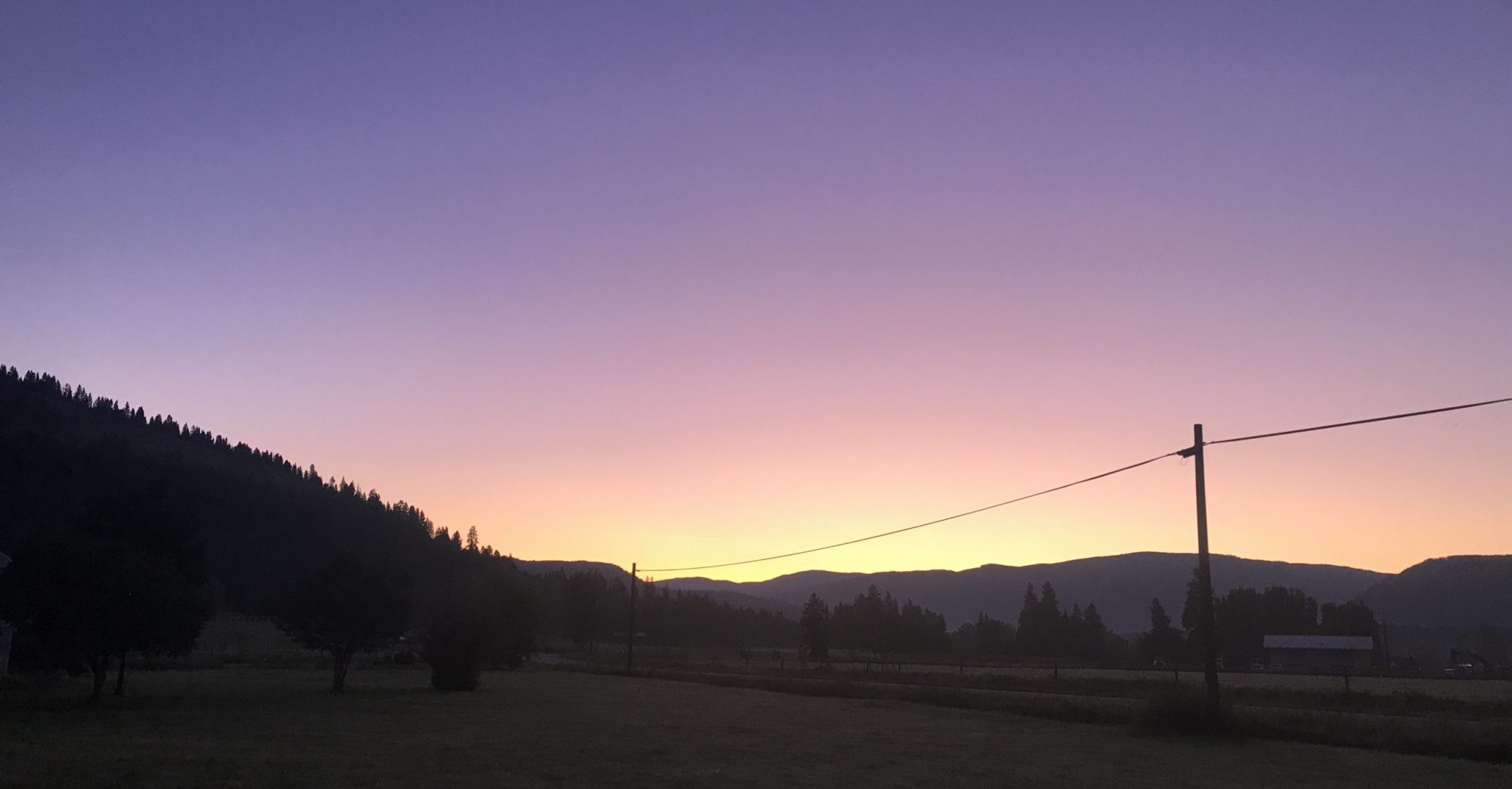Task 9 – Network Assignment using the Golden Record
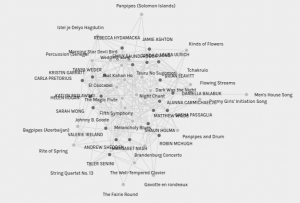
What a jumbled mess … when I first opened the Palladio program and uploaded our class file I honestly just stared at the screen for a bit. After not being able to make much sense of it, I started to zoom in and out, finding clarity when I could recognize names of classmates and songs. I started to see their links.
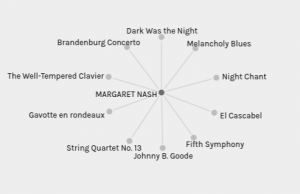
When I looked at only my own name, the graph became easier to understand. As described in System Innovation’s video “Graph Theory Overview” (2015), I recognized these undirected graphs – that connections, or edges, between the nodes have no direction. Our names are linked to the songs we chose and the songs are linked to our names.
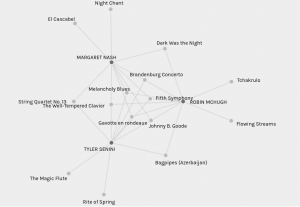
Looking at the smaller group I was put in on Palladio, I noticed that Robin, Tyler and I shared 6 songs – not bad considering there were 27 to choose from! There were other adjacent relations between songs and one other person. Oddly symmetrical was the fact that each of us had two songs that neither of the other two picked.
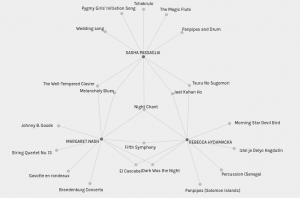
Intrigued looking at the relations between members of the group I was assigned, I wanted to compare my choices with another group. Seeing as we were just about to start the ETEC 565S summer institute, I grabbed my project group to compare our choices. The visual layout of this multiplex network was beautiful! We only share one song in common so it appears that the network is resonating from the node of “Night Chant“.
A definite downfall of these groupings is that the rationale for choosing a song is not considered. For example, I chose the 10 songs that I liked the most and/or had a positive memory that the song reminded me of. In speaking with some classmates, they chose some songs that they did not like to include in their 10. This means that even though there are relations between nodes (people and their song choices) it does not mean that these people necessarily have similar interests or things in common.
This has implications for networking search functions on the web because when people are searching for something, they may be broad in their search terms. This may link their search to information that does not align to their idea of the topic they were searching. These relations between nodes (search terms) could be very arbitrary.
These assumptions about relations has far reaching implications. From a political standpoint, just because two people have the same political affiliations does not mean that they have similar views, ideas or interests. More research would be needed to determine if they had anything else in common.
Lastly, out of interest, I looked at the songs instead of the people to see which ones were picked the most and the least. The most popular song chosen (by 17 people) was The Fifth Symphony which is not surprising given its popularity in popular culture. Interestingly, all of the 27 Golden Record songs were chosen – at least once. And only one song had just one person pick it: Men’s House Song. I thought I’d link it here so it could maybe get a bit more play! After listening to it again, I still don’t think I would include it on my short list …
_______________________
System Innovation. (2015, April 18). Graph Theory Overview. Retrieved from https://www.youtube.com/watch?v=82zlRaRUsaY&feature=emb_logo
System Innovation. (2015, April 19). Network Connections. Retrieved from https://www.youtube.com/watch?v=2iViaEAytxw
Task 8 – Golden Record Curation

Looking and listening through the Golden Record, it was so difficult to narrow the 27 recordings to 10. Considering this was sent into space over 40 years ago, these recordings are very much a snapshot in time. I believe was one of the pieces that made this task difficult. Also, many of the tracks are recordings that we just don’t hear regularly in mainstream media here in Canada.
But, like Dr. Smith Rumsey discussed in her lecture “Digital Memory: What Can We Afford to Lose” (2017), we need to look at the past to determine what is needed for the future. These songs have helped to lay the foundation for music as it is today.
I chose my songs based on personal connections and memories. Very few of these songs do I listen to today. The first five songs I chose include some of the classical tracks on the record. While I don’t normally listen to classical music, ever since my first year at UBC in 2000, I have listened to classical music while studying, completing assignments or working on report cards.
- Bach, Brandenburg Concerto No. 2 in F. First Movement, Munich Bach Orchestra, Karl Richter, conductor.
- The light tones of the flute make this an easy “studying song.” To be stereotypical, most girls played wind instruments while I was in high school band, but I didn’t want to sit in the front (see #8 below for my choice of instrument).
- Bach, “Gavotte en rondeaux” from the Partita No. 3 in E major for Violin, performed by Arthur Grumiaux.
- I would love to be able to play the violin and admire the few friends I have that play.
- Bach, The Well-Tempered Clavier, Book 2, Prelude and Fugue in C, No.1. Glenn Gould, piano.
- I took piano lessons for many years as a child. I still love hearing the impact of light touches on the keys.
- Beethoven, Fifth Symphony, First Movement, the Philharmonia Orchestra, Otto Klemperer, conductor.
- This is a classic. I love the progression and feeling from just the first four notes.
- Beethoven, String Quartet No. 13 in B flat, Opus 130, Cavatina, performed by Budapest String Quartet.
- A smooth romantic song, this was one that had in my regular study music rotation.
- “Johnny B. Goode,” written and performed by Chuck Berry.
- I love classic rock so this was an easy choice. A true “classic”.
- “Dark Was the Night,” written and performed by Blind Willie Johnson.
- As a fan of the blues, the slide guitar in this song is beautiful. His smooth humming adds a solemn tone to compliment the guitar.
- “Melancholy Blues,” performed by Louis Armstrong and his Hot Seven.
- The brass is what gets me with this song. I played the trombone for 7 years and still pick out the notes behind the trumpet! While I haven’t kept up with playing, I still love the tone of brass instruments.
- Navajo Indians, Night Chant, recorded by Willard Rhodes.
- I was lucky to get my first teaching job in Lillooet, BC in 2005. A community rich in indigenous culture and history, this song reminds me of our many events we hosted at the school to ensure the local songs and dances were remembered.
- Mexico, “El Cascabel,” performed by Lorenzo Barcelata and the Mariachi México.
- This track reminds me of nights at Las Margarita’s on 4th Avenue in Vancouver during my earlier years at UBC! There was often live music from a corner of the room setting a lively mood.
_______________________________________________________________
Click here for a playlist of the Golden Record.
_______________________________________________________________
Reference:
Brown University. (2017). Abby Smith Rumsey: “Digital Memory: What Can We Afford to Lose?”. Accessed via YouTube at https://www.youtube.com/watch?time_continue=4&v=FBrahqg9ZMc&feature=emb_logo
Task 7 – Mode Bending
I struggled with this task a lot this week. With the very brief assignment description on Canvas, I just didn’t know where to start. Luckily I had already read the New London Group (1996) article last semester, so the re-read made their concepts and ideas easier to understand.
When I didn’t know how to approach this task, I was drawn to Figure 1 from The New London Group (p. 83) of the metalanguages to describe design elements and modes of meaning. Knowing this task was to be auditory, I used a few sounds effects and a snip-it of music, but felt the need for something else.
As I looked around while I was sitting in my “bag”, I was drawn to the colours surrounding me. I decided that would be the perfect compliment to my podcast-style recording.
I hope you enjoy the cheeky nature of my post and that it gives you a bit more insight into who I am!
__________________________________________
The New London Group. (1996). A pedagogy of multiliteracies: Designing social futures. Harvard Educational Review 66(1), 60-92.
Task 6 – Emoji Story!
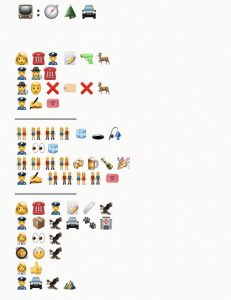
I really enjoyed this task, even though I only use emojis sporadically in my texting – and VERY rarely for entire thoughts or phrases!
I don’t watch a ton of TV or movies so I picked a show that my kids (and inevitably me) watch some mornings before school. If you’ve visited my “about me” section and my initial blog post, you’ll see a common theme! I also thought this show would/could be relatively straight forward to find emojis for the main characters and situations.
I focused mostly on the individual words to summarize, more than the concepts. I think this is a result of the fact that I don’t use a ton of emojis so my creativity is weak in this area!! One thing I did discover, and it is a function of our current society of the last few years, that there is no longer an emoji for a rifle or gun on most platforms – only a squirt gun!! This is something that I didn’t even consider, because as a hunter I have a specific and strict use for my firearms.
I started with the title because I felt it was quiet straight forward – plus I like to start things at the beginning and move to the end. It is similar to how Kress (2005) explained that traditional writings and pages will still exist, despite the new push to allow readers to “enter” a document at any stage (such as online textbooks). Those of us who are used to writing will continue to produce things as such, but the upcoming generation will change things to become more image and link based, so they can access only the information they need (without having to sort through everything else!
In this week’s reading of chapter 4, Bolter (2001) refers to “ekphrasis” and the concept that we need to grasp for this task was his notion of “reverse ekphrasis,” meaning that instead of words evoking images or sensory experiences, we are using images to infer the words. It’s an interesting concept, as I think this reverse ekphrasis involves much more cognitive muscle to decipher what the string of emojis mean! It’s something that is challenging and can have hilarious results (as seen on Ellen’s Game of Games)! Also, as someone who doesn’t watch a ton of TV or movies I think I will struggle with figuring out my classmates stories.
The deciphering of emojis is definitely something that takes practice!
————————
Bolter, J. D. (2001). Writing space: Computers, hypertext, and the remediation of print. Lawrence Erlbaum Associates.
Kress (2005), Gains and losses: New forms of texts, knowledge, and learning. Computers and Composition, Vol. 2(1), 5-22
Task 5 – Twine!
Well this was something totally new for me. I was so hesitant at first and had thoughts about not completing this task, but I’ve already opted to not do one, so I wanted to leave my other opt out for a time when I may need it!!
I am not a gamer. I have limited experience with writing code or designing online platforms or games. I will admit I was confused after “playing” The temple of no, but I’m sure it was because I was only half paying attention to the content and was trying to think ahead to my own use of Twine.
I started by opening a Google Doc and starting on my story. This really helped because I was sitting outside the hockey rink while my kids had a little practice with a coach friend and didn’t have my laptop. Not sure of the capabilities of starting this on my phone, I just started typing in the doc to get my story going. Once I started, it came together pretty well.
I struggled through the formatting, finding a style I liked and getting the background and font colours to change. I then entered the rabbit hole of adding pictures! I had to stop myself, because I was taking WAY too long to find the right picture and I don’t have a ton of time to spare these days with the end of the school year (and report cards) approaching.
I enjoyed having the story link together and do admit that I was a fan of the Choose Your Own Adventure novels of the 1980s. I found this week’s reading enlightening as we really have always linked our new and current knowledge to that of the past – it’s nothing new. We are in a time where things are changing like crazy and people are always looking for simplified versions of things. Like Bolter reference’s “electronic hypertext is not the end of print; it is instead the remediation of print” (p. 46). We are not reinventing the wheel, just changing things to keep up with the times!
I hope you enjoy my story – it’s a choose your own adventure that all leads to the same moral, that is probably a common parental frustration! It’s a constant struggle in my life, so hopefully you will see some comparisons to your own lives and maybe even giggle a bit.
Click on the link below and download it to your computer to play. I hope you enjoy!
What’s for Dinner
_____________________________________________________________________
Bolter, J. D. (2001). Writing space: Computers, hypertext, and the remediation of print. Lawrence Erlbaum Associates.
Task 4 – Manual Scripts
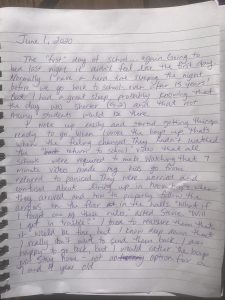
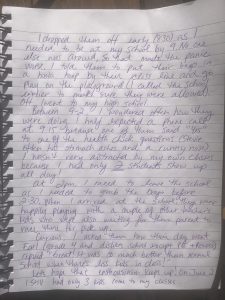
For this week’s task I had a hard time deciding which to do – the potato stamping intrigued me, but I was having a hard time finding a 5 letter word that I really liked!! And with returning into my school (and having to send my own boys back to school, even though I really don’t want to send them), I thought I could reflect on our first day back, Monday June 1. My reflection is to the point and accurately reflects my feelings about that day.
- Do you normally write by hand or type? Did you find this task difficult or easy?
While I still write my lists by hand, most other written work I do is typed. I have never been one to have a journal or regularly record my thoughts on paper. I was surprised how easy it was to write these two pages – probably because it was a reflection of the previous day and it was about events that I feel passionate about. The words flowed easily and I was surprised at the lack of mistakes I made. I was happy with how my thoughts were fairly clear and concise – when reading it back there would really only be a few changes I might make or details I would add.
The cognitive piece of this was easy, but what was hard was the physical part: the writing of two pages of words was PAINFUL! I have dealt with carpel tunnel-like symptoms for years and I find that my arms and hands go numb easily. As someone who doesn’t write regularly I didn’t know the impact it would have. Toward the end of the first page, my hand started tingling just a bit. By the time I started the second page, my hand was completely numb! It was so hard to hold on to the pen and get the words to paper. I had to stop regularly and give my arm a shake, which didn’t really help. I could not even imagine being a monk as described in this week’s podcast from How It Began: A History of the Modern World on “The Printed Book: Opening the Floodgates of Knowledge.” I could not sit by candlelight writing precise lettering all day, every day!
- What did you do when you made a mistake or wanted to change your writing? How did you edit your work? Did your choice of media play a part in how you edited your work?
There were only a few times when I made a mistake or wanted to change my thoughts. I have always preferred to use a line or two to strike out the word. The best mistake I made was that I couldn’t remember how to spell luxury, so I just used another word! Spell check and auto-correct are two things that I believe have resulted in us not being able to spell anymore!
I did not edit my work, other than reading it over because I knew that if I was to make a bunch of changes, I would need to re-write it so that it was clear and clean! I chose to use a pen, because I wanted to get the full effect of this task – if I had used a pencil and eraser then others would not have seen the mistakes I made. Pen has always seemed more permanent, used when things are formal and meant to last. I feel like pencils are for fine art like drawing or painting and for applied skills tasks like carpentry – both delicate and used only for a guide to complete the final project.
- What do you feel is the most significant difference between writing by hand and using mechanized forms of writing? Which do you prefer and why?
Writing by hand is a beautiful, thoughtful and personalized way to convey our thoughts and ideas. I think there is still great value to writing (and receiving) hand written cards and letters. I know many people who type generic Christmas letters to send to everyone in their cards and even have some relatives who don’t write a thing – Just the card with names signed at the bottom (not addressed to anyone) and then the generic letter. In all honesty, I want to see something personal. That’s why I don’t send a ton of cards, but do take the time to write little personal message in each one I do send. The downfall is writing by hand takes time, of which we often don’t seem to have enough of.
Using a computer or phone to type is absolutely essential to my work as a teacher. I need to be able to quickly and easily communicate with my students and their parents. It needs to be professional, legible and the spelling/grammar flawless to properly convey my thoughts. I find I am able to give all students detailed, personalized, strength-based comments on their work because typing is so much faster. The efficiency is what is key for me.
All of this said, if I had to pick one way, it would be mechanized writing. At work, I just can’t picture going back to the days of handwritten report cards and waiting for the mail. Although, if given the option I may just move to the bush (see my Blogging in the Bush post!) – then I may have the time to perfect my writing and will have the patience to wait for the mail.
Task 2 – Does Language Shape the Way We Think?
After reading Lera Borditsky’s article this week, I was intrigued. I found myself making connections to my own life and learning, asking myself questions to further understand and relate to her writing. When this task was annotating her SAR lecture, I knew I would have many points to connect with.
I found the annotating process quite easy, although there were times I needed to re-watch segments to collect my thoughts. Only one other student had annotated the video before I did, so I found myself reading her thoughts while considering my own. Now I see many others have annotated the lecture and I have enjoyed reading their comments and questions.
Task 1 – What’s in Your Bag?
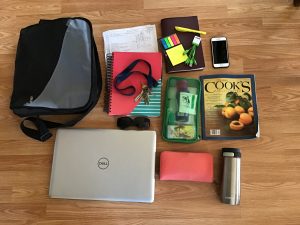
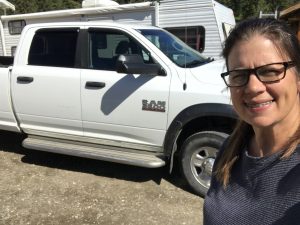
I am not a person that uses a bag or purse regularly. My truck acts as a bag – I just take what I need when I get out and I’m good to go! I find when I do have a bag, it ends up like a dumping ground for everything and anything.
That said, I do bring a bag to work, but I don’t use it much. And now that I’ve started the MET program (this is course 3 for me), I have needed to bring a bag with me to school (when we were allowed in) and on weekend trips. This is a representation of what I keep in my school/work bag.
- Bag – this is a cheap laptop bag that I bought out of need for a trip to UBC Vancouver for a Home Ec conference last year. I am frugal at the best of times, so I found one that looked like it would fit everything and wasn’t expensive. The zippers are important as my boys (7 and 9) like to “help” with things, but that usually just means that they pick things up upside down …
- Laptop – I bought a new laptop and opted for one with a larger screen so that it would be easier to read what I’m working on online. Apparently the larger screen is ideal for gaming, of which I do none!
- Wallet – I opt for a bigger wallet because I don’t carry a bag. My wallet has everything I need in it, including my hunting license and tags! Pink is my favourite colour, so I couldn’t resist this salmon coloured wallet from ThirtyOne Bags.
- Coffee – I rarely start a morning without a cup or two, so I usually have one I bring with me when I leave the house. I more often use a mug even in my truck, but I’ve had a few spills so a to-go cup is the way to go.
- Sunglasses – I don’t go anywhere without them as they are prescription and I can’t see without glasses! They are 15 years old, so I will probably have to get some new ones soon.
- Notebook – I always make sure I have a notebook handy as I make a lot of lists and need to have them written down! I’ve tried to use my phone but I prefer handwritten. Right now it also holds my class lists so I can keep track of attendance and assignments for my classes while we are learning at home.
- School keys – If I don’t keep them in the bag (or truck), I am always forgetting them.
- Green bag – I am lucky enough to have braces at 38 years old! So I always have this with me so I can brush, floss or adjust the elastics. I also have some personal care items in there that I may need (especially Advil!).
- Cook’s Illustrated – As a Foods teacher I always tend to have a magazine close by with recipes and tips/tricks for the kitchen. A great way to pass the time!
- Cell – what can I say. I couldn’t live without it. I’ve stuck with the iPhone since getting rid of my Blackberry in 2008. I use the dongle to attach my phone to various devices.
- Daytimer – I wear many hats these days (teacher, student, minor hockey president) and have two active kids, so a daytimer is a must! Just like my lists, I try and use my phone, but I find I need to write things down. The sticky notes and highlighter help me stay organized.
Text Technologies
Some of these items are purely functional – like the laptop bag and the coffee mug. But all of the others either contain text technology or are instrumental in developing it.
Some of the items are a daily need, not just for work but to get through the day. If I didn’t have my glasses I couldn’t read any text! And my cell phone is a necessity to ensure that my boys are able to contact me (they are old enough to text with Messenger Kids so it’s always neat to see what they write! (And they are already proficient in emoji speak!).
The text that appears in my wallet is pivotal to who I am. My driver’s license shows my current home in the Okanagan, while my Teacher Qualification Service card shows signs of my young life with my maiden name (that still appears for my courses as I haven’t changed it!). My firearms and hunting licenses show my connection to the outdoors. Because of the text written on these cards I am able to ethically harvest the most organic of meats to feed my family.
My work is surrounded by text, with recipes and oral histories surrounding the preparation of food. The Cook’s Illustrated cookbook highlights the technical side of my job – exquisitely written descriptions of how to complete both the most simple and obscure tasks in the kitchen. Images help to provide a clear picture to the reader about the method to strive to achieve. I often have to rewrite or re-phrase these descriptions as my students often don’t understand. My marks are a text of numbers, accented with technology to ensure that each student knows the specific number that they have achieved (but does that really mean anything?).
My bag makes me look a bit more organized and “academic” than my outward image. While I am always hard working yet laid back, my work persona that is captured more in this bag is more structured and polished than the side my friends and family get to see. I teach at a fairly affluent school where not many students hunt, fish or camp, so I work hard to explain to my students through pictures and stories, why I choose to live the life I do.
My bag would have looked similar 15 years ago, as I had just started my first teaching job and was living alone in Lillooet. I would not yet have met my husband, who introduced me to hunting, meaning my mindset would have been different. The biggest difference would be the cell and laptop technology – I explained to my students not long ago that they don’t know the feeling of accomplishment when texting a long message, having to press the numbers three times to get the third letter!
In the future, looking back at this bag people may question the need for both digital and written text. I feel we are on the cusp of losing most handwritten text, shifting everything digitally and online. Schools regularly require students to type projects and use fillable PDFs. Most students writing is poor – they are not able to handwrite and don’t have a signature! But will we need a handwritten signature in the future? Only time will tell.
